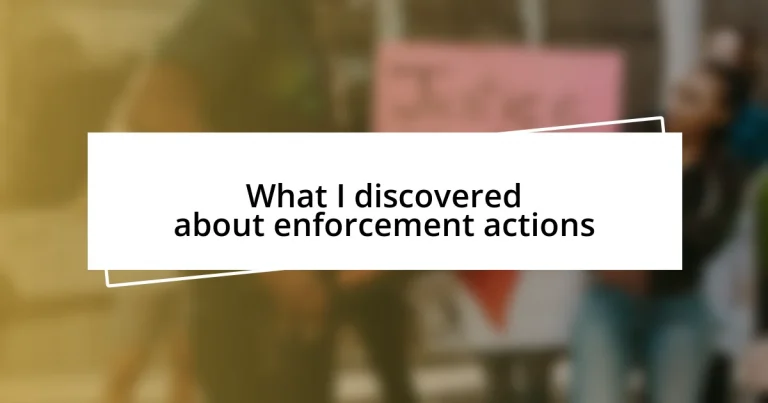Key takeaways:
- Enforcement actions serve to uphold laws and promote accountability, aiming to prevent future violations and protect public interest.
- Understanding different types of enforcement actions, such as civil, criminal, administrative, and self-reporting, is vital for navigating regulatory landscapes.
- Proactive compliance strategies, including regular audits, ongoing training, and clear communication with regulators, are essential in avoiding enforcement actions.
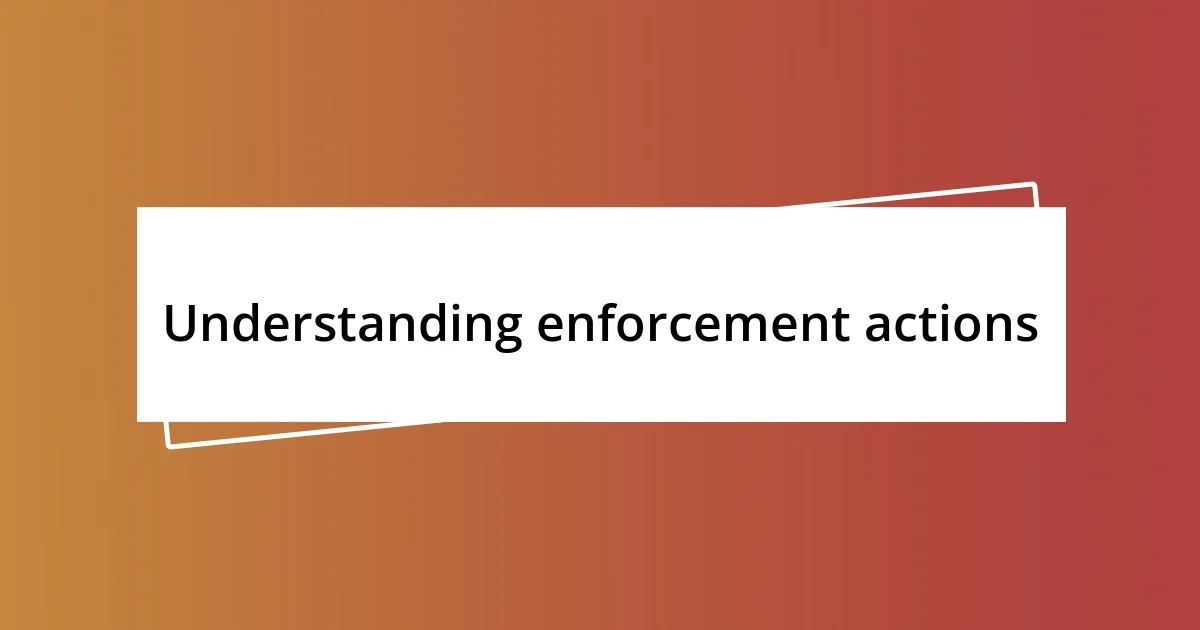
Understanding enforcement actions
Enforcement actions can feel overwhelming, but understanding their purpose is crucial. They serve as a mechanism for authorities to uphold laws and regulations, essentially functioning as a form of accountability. I remember when I first encountered an enforcement action in my professional life; it felt like a wake-up call about the importance of compliance.
When you think about enforcement actions, have you ever considered their broader implications? They’re not just punitive; they aim to prevent future violations and protect the public interest. I once worked on a project where an enforcement action against a company led to a major shift in their practices. The employees were shaken initially, but ultimately, it fostered a culture of transparency and responsibility within the organization.
Additionally, the process can vary widely depending on the jurisdiction and the nature of the violation. This variability can create confusion, especially for those unfamiliar with legal frameworks. I can recall a situation where a colleague was unsure of their rights during an enforcement action, leading to unnecessary stress. It’s a reminder that understanding these actions is empowering and essential for anyone navigating regulatory landscapes.
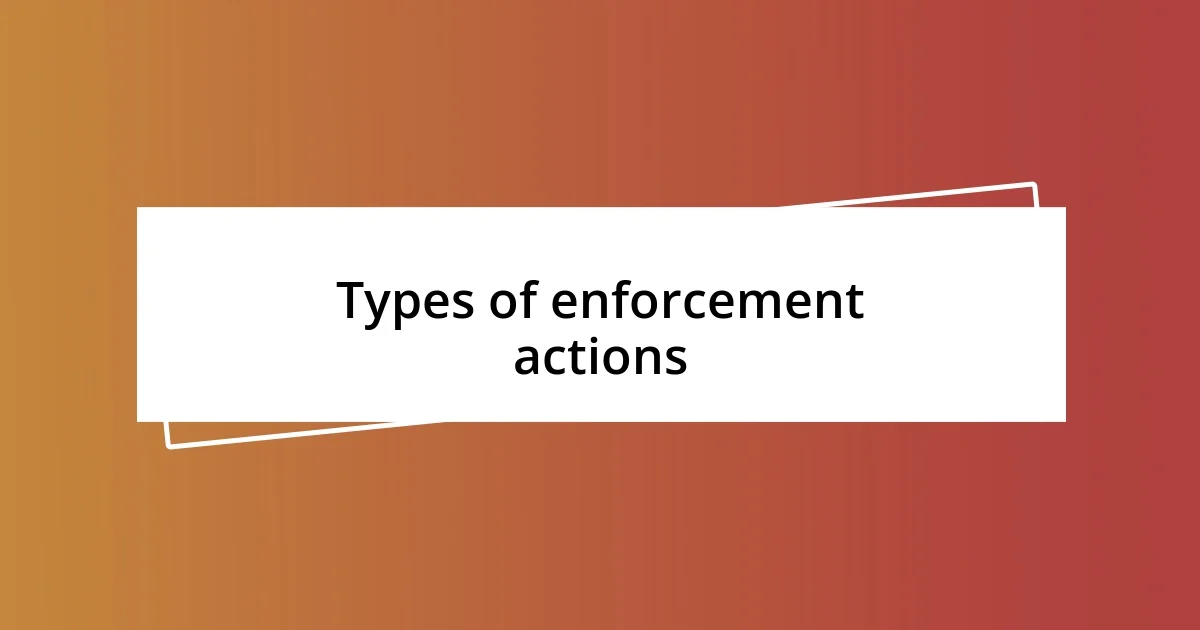
Types of enforcement actions
When it comes to enforcement actions, they typically fall into a few distinct categories. You’ll often encounter civil enforcement actions, which aim to address violations without criminal intent, like regulatory penalties for failing to comply with laws. In contrast, criminal enforcement actions involve prosecutions where the state seeks to punish wrongdoing, often resulting in fines or imprisonment. Reflecting on my career, I’ve seen how companies are quick to address civil infractions, understanding that the impact on their reputation can be significant.
Another type that’s quite relevant is administrative enforcement, typically initiated by a regulatory agency. I remember a client facing an administrative action; they were initially defensive but learned that cooperating could ultimately lead to a more favorable outcome. Then there’s also the self-reporting option, where organizations voluntarily disclose violations to regulatory agencies. Having seen firms engage in self-disclosure, I can vouch for its potential to mitigate consequences and foster relationships with regulators.
To bring some clarity to these categories, here’s a comparison table:
| Type of Enforcement Action | Description |
|---|---|
| Civil Enforcement | Adds penalties for regulatory violations without criminal intent. |
| Criminal Enforcement | Involves prosecution for offenses, seeking penalties such as fines or imprisonment. |
| Administrative Enforcement | Initiated by regulatory agencies, often focusing on compliance. |
| Self-Reporting | Voluntary disclosure of violations to regulators, potentially reducing penalties. |
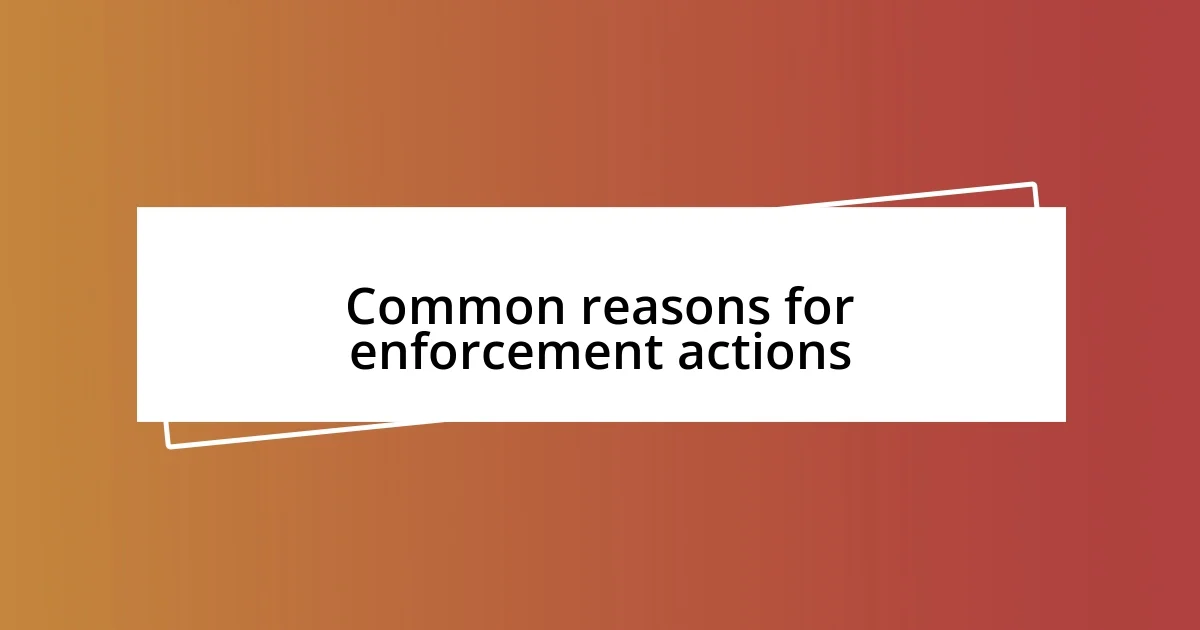
Common reasons for enforcement actions
Common reasons for enforcement actions often stem from a range of violations that can put public safety and fairness at risk. I recall a time when I worked with a startup that faced enforcement due to inadequate safety protocols. It was alarming to see how one oversight could lead to a serious investigation, emphasizing the necessity for companies to prioritize compliance from the get-go.
Here are some of the most common triggers for enforcement actions:
- Regulatory Noncompliance: Failing to adhere to industry regulations, like environmental or safety standards.
- Fraudulent Activities: Engaging in deceptive practices, such as financial fraud or misleading advertising.
- Negligence: Poor practices that lead to harm, such as inadequate training for employees or not maintaining equipment.
- License Violations: Operating without the necessary licenses or permits required by authorities.
- Data Breaches: Failing to protect sensitive information, risking consumer privacy and security.
In my experience, I’ve seen how even minor lapses can snowball into monumental issues, making it clear that a proactive approach is essential. When companies neglect to follow the rules, the consequences can be far-reaching, affecting not just their bottom line but also the trust of their customers.
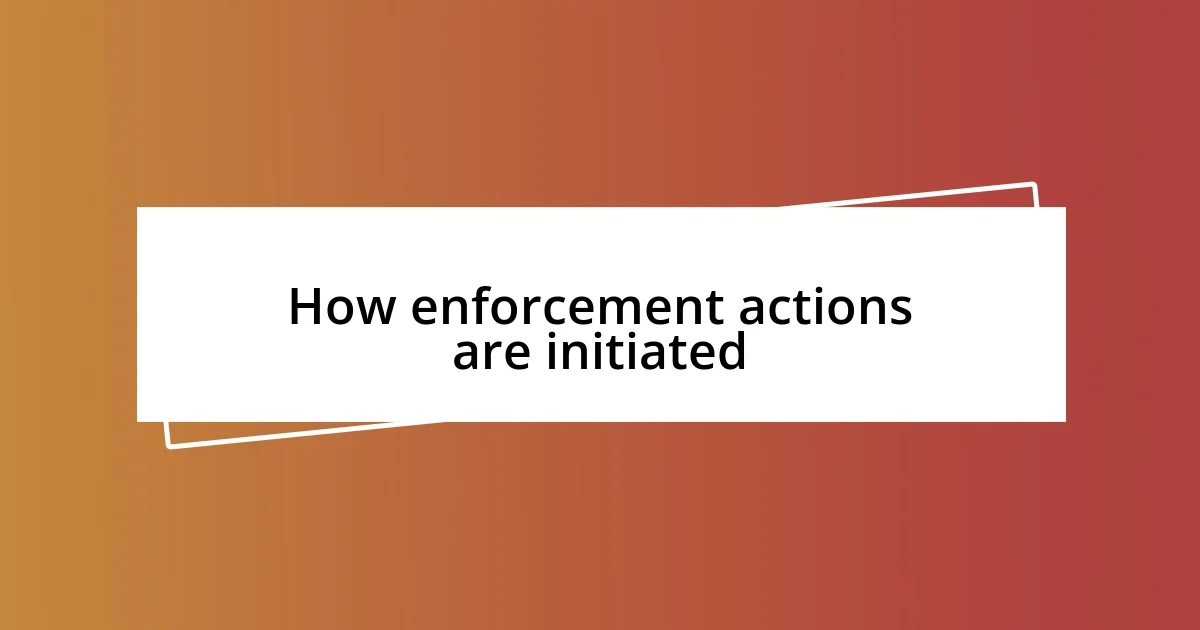
How enforcement actions are initiated
Enforcement actions are typically initiated through a variety of channels, often starting with complaints or reports. I remember a situation where a whistleblower alerted a regulatory agency about unsafe practices at a manufacturing plant. This sparked an investigation that unfolded into a full-blown enforcement action, reminding me just how critical it is for employees to feel empowered to speak up.
Regulatory agencies often collect data from various sources, like audits, inspections, and even tips from the public. In one instance, I witnessed an environmental agency use satellite images to detect illegal dumping. It’s striking how technology can play a role in uncovering violations, leading to swift enforcement action that forces companies to take compliance seriously.
Another common pathway to initiating enforcement actions is through ongoing surveillance or monitoring. I once worked with a bank that faced scrutiny due to automated systems flagging unusual transactions. This prompted a thorough review and led to an enforcement action that addressed significant lapses in compliance. Isn’t it fascinating how sometimes, the unassuming mechanisms we have in place can trigger major legal repercussions?
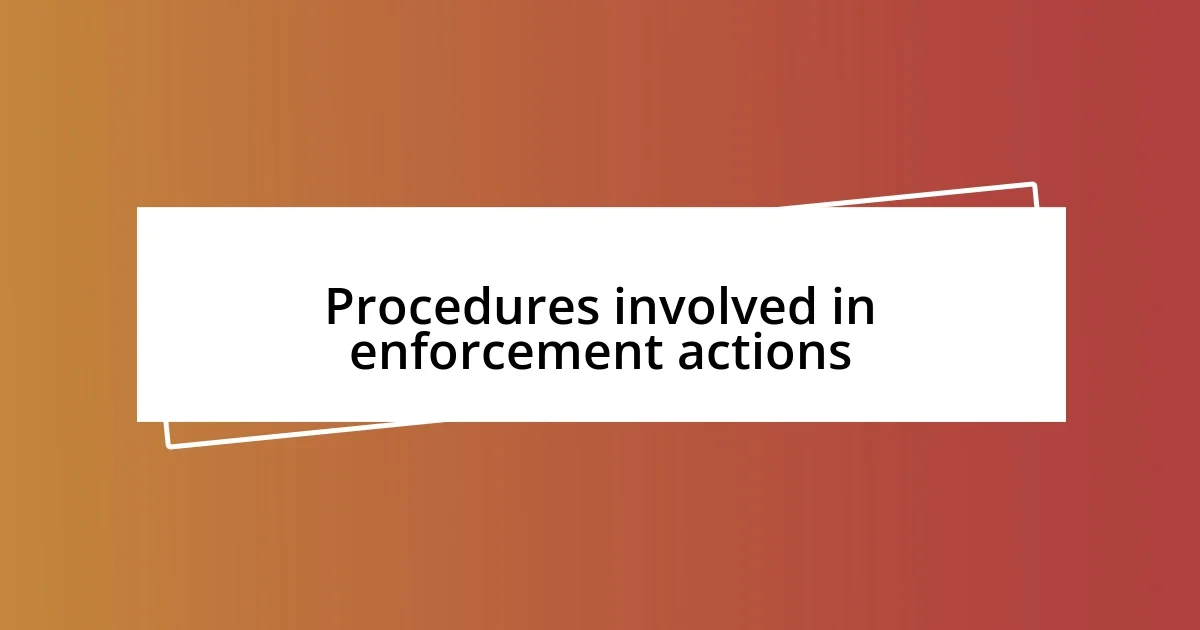
Procedures involved in enforcement actions
The procedures involved in enforcement actions can be quite intricate, often beginning with a thorough investigation. In my experience, I’ve seen regulatory agencies gather evidence meticulously, which can include interviews, documentation, and even site visits. I once observed a team of inspectors meticulously comb through records at a facility, and it struck me how detailed these inquiries can be; every piece of information is vital in forming a clear picture of compliance—or non-compliance.
Once enough evidence is gathered, the agency typically issues a notice of violation. I recall a case where a corporation received a formal notice for failing to meet emissions standards, and you could feel the tension in the air. It’s a pivotal moment. Companies often realize their choices have serious repercussions, and it forces them to reassess their practices under the microscope of public scrutiny. Can you imagine the anxiety that comes with waiting to hear how the agency will respond?
The next phase involves a hearing process, which provides a platform for the company to present its defense. I remember discussing with a colleague how daunting this must feel for those involved; it’s like standing in front of a jury, hoping to convince them of your innocence. During this process, I’ve noticed that having a solid legal strategy and clear communication can make a significant difference in the outcome. It’s a reminder that preparation is key, and in enforcement actions, every detail counts.
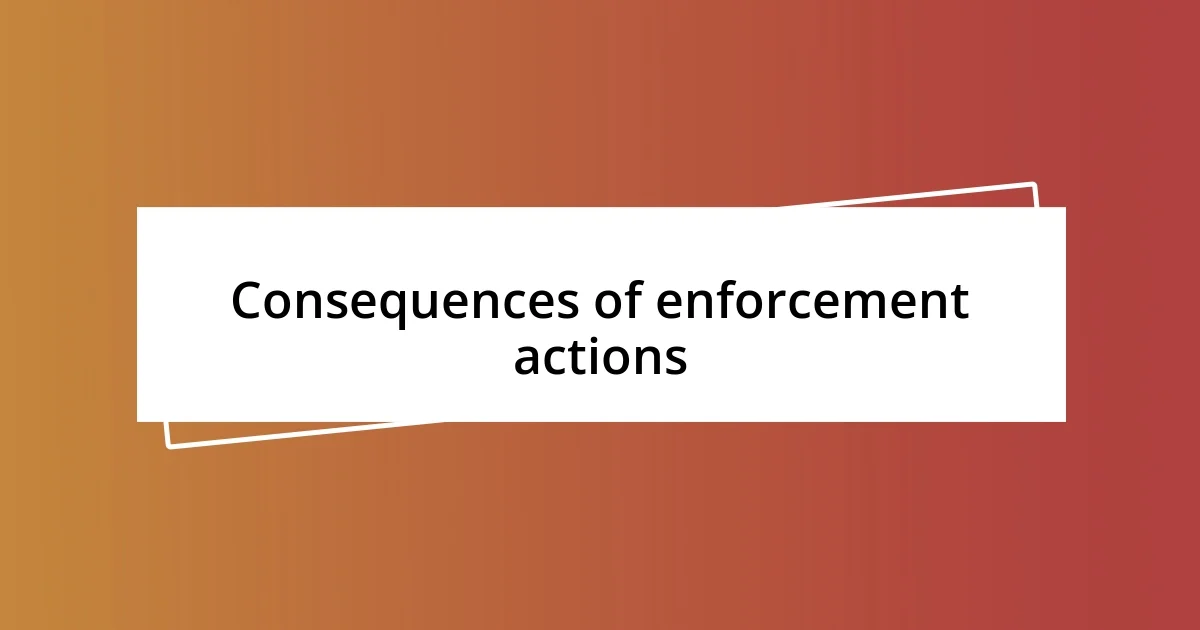
Consequences of enforcement actions
The consequences of enforcement actions can be profound, both for businesses and individuals alike. I can recall a friend who worked for a tech company that faced an enforcement action for data breaches. The fallout was immediate; clients started pulling contracts, and the company’s reputation took a significant hit. It’s hard not to feel a sense of urgency in situations like this—who wants to work with a company that is under investigation?
In my experience, financial penalties often accompany enforcement actions, and they can be staggering. I vividly remember attending a conference where a compliance officer discussed a situation in which their organization incurred millions in fines due to repeated violations. Hearing the stress in their voice made me wonder: how many sleepless nights do you think were spent worrying about the company’s future? The financial repercussions can shape not only a company’s bottom line but also its culture, forcing a shift towards stricter compliance protocols.
Moreover, the emotional toll on employees shouldn’t be underestimated. I once supported a team during a tumultuous period after their organization faced a public enforcement action. The anxiety was palpable, and morale plummeted. It made me reflect on the human aspect of these consequences; how often do we talk about the stress staff endure amidst corporate crises? It really struck me how interconnected compliance and employee well-being can be, underscoring the broader impact enforcement actions can have beyond mere legalities.
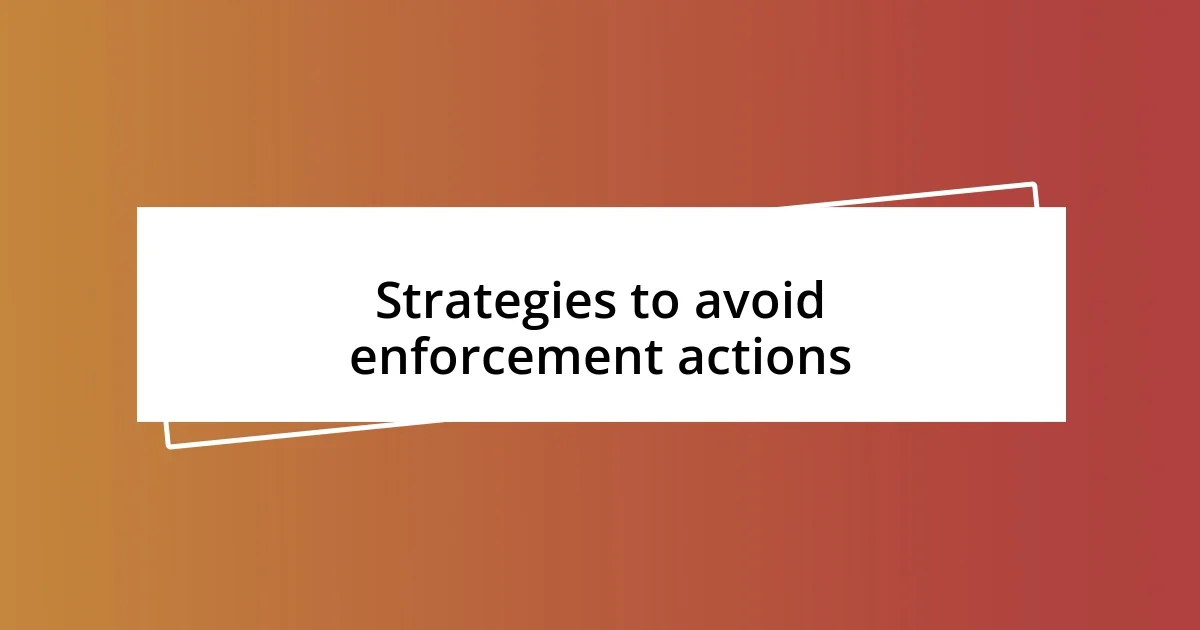
Strategies to avoid enforcement actions
Adopting a proactive compliance strategy is one of the most effective ways to sidestep enforcement actions. For instance, I remember working with a startup that prioritized compliance from the get-go. They established regular audits and embraced a culture of transparency, which not only kept them in line with regulations but also created an environment of trust among employees. Can you imagine how empowering it felt for everyone to know they were on solid ground?
Another key strategy is engaging in ongoing training programs. I once joined a workshop where industry leaders shared their experiences, and it was enlightening to see how dedicated those companies were to keeping their teams informed. It reinforced my belief that regular training can demystify regulations and empower employees. Have you ever felt overwhelmed by new regulations? Consistent training can alleviate that anxiety, transforming what feels like a mountain of rules into manageable steps everyone understands.
Lastly, clear communication with regulatory agencies can make a significant difference. I recall a situation where a company faced a potential enforcement action but took a proactive approach by reaching out to regulators before issues escalated. This open dialogue allowed them to clarify misunderstandings and ultimately avoid penalties. When I think back on that case, it becomes evident: fostering relationships based on honesty and transparency can be an invaluable safeguard against enforcement actions. How confident are you in your ability to communicate with authorities if a problem arises?












